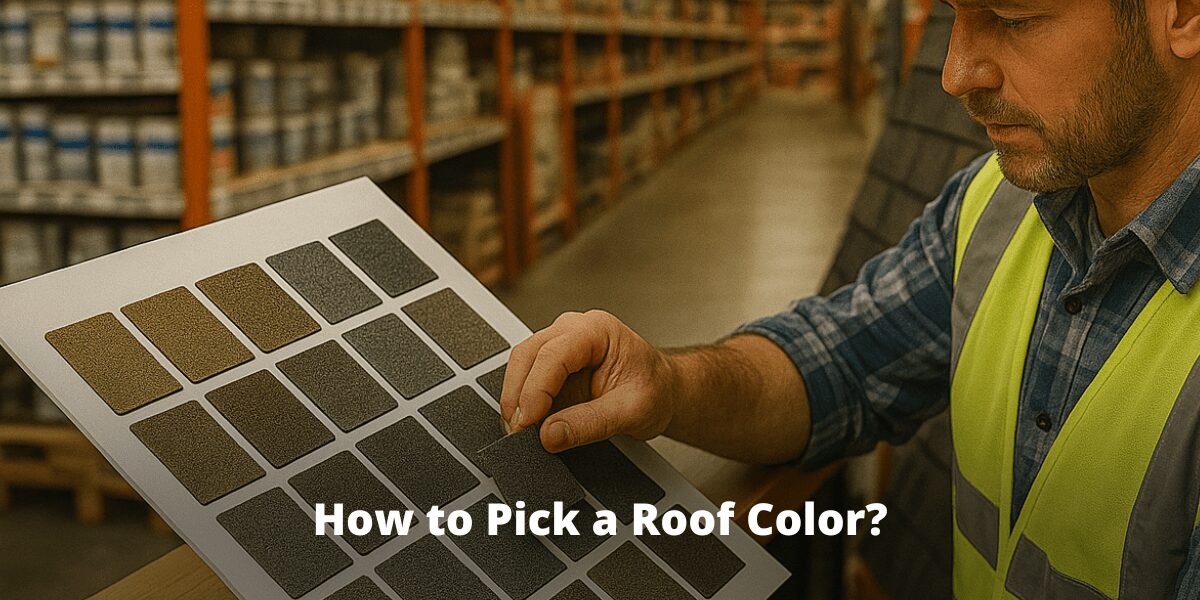Roof color might not seem like a big deal—until it’s your turn to choose one.
Then suddenly, it’s tied to everything from how hot your home gets in summer to whether your house stands out for the right reasons.
But there is good news: A few practical rules can take the guesswork out of it.
We’ll break down how to pick a roof color that works long-term.
Key Notes
- Match roof color with architectural style and surrounding landscape for cohesive curb appeal.
- Consider climate factors—darker roofs absorb heat while lighter colors reflect sunlight.
- Coordinate with existing exterior elements like siding, brick, and neighborhood aesthetics.
- Test samples in different lighting conditions before making your final decision.
What Influences Roof Color Choice?
Climate and Regional Considerations
The local climate should significantly influence your roof color selection.
In hot, sunny climates, lighter roof colors reflect more sunlight, reducing cooling costs by 20-30%. Conversely, darker roof colors are beneficial in colder climates as they absorb heat, aiding snow melt and reducing heating demands.
Regional trends also play a role, with specific colors being more prevalent in certain areas, such as terra cotta in the Southwest or classic blacks in New England.
Architectural Style and Neighborhood Context
Your home’s architectural style is a guiding factor for roof color selection.
For instance, a Colonial home might suit a dark gray or black roof, while a Mediterranean style could benefit from terra cotta or warm brown.
Additionally, neighborhood cohesion is important; while your roof doesn’t need to match your neighbors’ exactly, it should harmonize with the overall aesthetic of the area.
Roof Color and Energy Efficiency
Roof color significantly impacts your home’s energy performance.
Lighter roofs generally have higher Solar Reflectance Index (SRI) values, reflecting more solar energy and staying cooler, which is advantageous in hot climates.
Darker roofs, while potentially increasing cooling demands, can provide heating benefits in colder regions.
Technical Insights into Energy Efficiency
Two key factors determine a roof’s thermal performance: solar reflectance and thermal emittance.
Modern “cool roof” options use specialized pigments to improve the SRI of darker colors, enhancing energy efficiency without sacrificing color preference.
Comparing Roofing Materials & Their Color Options
Different roofing materials offer varying color palettes and performance characteristics.
Roofing Color Options
|
Material-Specific Color Considerations
|
Practical Tips for Choosing the Right Roof Color
|
Making Your Final Roof Color Decision
|
Frequently Asked Questions
How much does roof color affect my home’s energy efficiency?
Roof color can impact energy costs by 20-40% in extreme climates. Light-colored roofs can be 50-60°F cooler than dark roofs in summer, potentially reducing cooling costs by 7-15% in hot regions.
Are there any HOA or municipal restrictions I should be aware of when choosing roof colors?
Many homeowners’ associations and some municipalities have specific guidelines or restrictions regarding roof colors and materials. Check your HOA bylaws or local building codes before making a final decision.
How often will I need to replace my roof if I choose a darker color versus a lighter one?
Darker roofs typically show less visible dirt and algae but may deteriorate 10-15% faster in sunny climates due to increased heat absorption. Lighter roofs generally last longer in hot regions but may require more frequent cleaning.
Can I change my roof color when replacing just a section of damaged roofing?
While possible, it’s generally not recommended as even slight color variations between new and existing materials will be noticeable. If you must replace a section, consider whether the visible contrast will be acceptable.
How do different roofing materials hold their color over time?
Metal roofs typically maintain color for 25-30 years with proper coatings. Asphalt shingles may fade 15-20% within the first 5-7 years. Concrete tiles hold color well but may develop patina. Clay tiles and slate maintain their natural colors longest, often for the life of the roof.
Conclusion
Choosing a roof color sounds simple—until you’re staring at 20 shades of a color that all look the same under showroom lights.
But when you break it down by climate, architectural style, material, and how it ties in with the rest of your home, the decision gets easier—and smarter.
Whether you’re going for curb appeal, energy savings, or resale value, the right roof color should work hard without drawing too much attention to itself.
If you’re replacing your roof or planning a new build, we’ll help you weigh your options and avoid costly missteps. Get your free quote today and start with expert advice that actually makes sense for your home.

